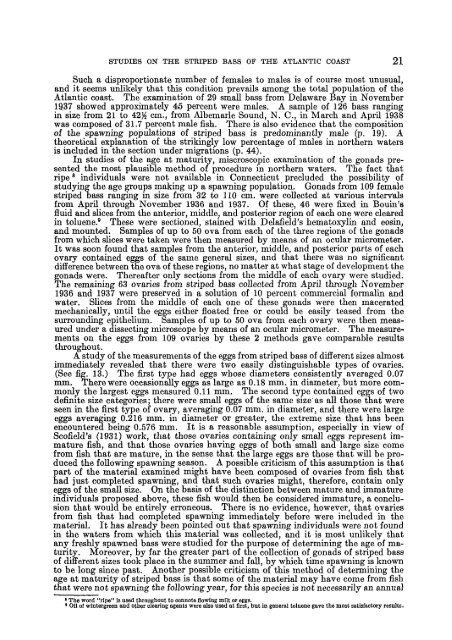Fishery bulletin of the Fish and Wildlife Service - NOAA
Fishery bulletin of the Fish and Wildlife Service - NOAA
Fishery bulletin of the Fish and Wildlife Service - NOAA
You also want an ePaper? Increase the reach of your titles
YUMPU automatically turns print PDFs into web optimized ePapers that Google loves.
STUDIES ON THE STRIPED BASS OF THE ATLANTIC COAST 21<br />
Such a disproportionate number <strong>of</strong> females to males is <strong>of</strong> course most unusual,<br />
<strong>and</strong> it seems unlikely that this condition prevails among <strong>the</strong> total population <strong>of</strong> <strong>the</strong><br />
Atlantic coast. The examination <strong>of</strong> 29 small bass from Delaware Bay in November<br />
1937 showed approximately 46 percent were males. A sample <strong>of</strong> 126 bass ranging<br />
in size from 21 to 42% cm., from Albemarle Sound, N. C., in March <strong>and</strong> April 1938<br />
was composed <strong>of</strong> 31.7 percent male fish. There is also evidence that <strong>the</strong> composition<br />
<strong>of</strong> <strong>the</strong> spawning populations <strong>of</strong> striped bass is predominantly male (p. 19). A<br />
<strong>the</strong>oretical explanation <strong>of</strong> <strong>the</strong> strikingly low percentage <strong>of</strong> males in nor<strong>the</strong>rn waters<br />
is included in <strong>the</strong> section under migrations (p. 44).<br />
In studies <strong>of</strong> <strong>the</strong> age at maturity, miscroscopic examination <strong>of</strong> <strong>the</strong> gonads presented<br />
<strong>the</strong> most plausible method <strong>of</strong> procedure in nor<strong>the</strong>rn waters. The fact that<br />
ripe 8 individuals were not available in Connecticut precluded <strong>the</strong> possibility <strong>of</strong><br />
studying <strong>the</strong> age groups making up a spawning population. Gonads from 109 female<br />
striped bass ranging in size from 3'2 to 110 cm. were collected at various intervals<br />
from April through November 1936 <strong>and</strong> 1937. Of <strong>the</strong>se, 46 were fixed in Bourn's<br />
fluid <strong>and</strong> slices from <strong>the</strong> anterior, middle, <strong>and</strong> posterior region <strong>of</strong> each one were cleared<br />
in toluene. 9 These were sectioned, stained with Delafield's hematoxylin <strong>and</strong> eosin,<br />
<strong>and</strong> mounted. Samples <strong>of</strong> up to 50 ova from each <strong>of</strong> <strong>the</strong> three regions <strong>of</strong> <strong>the</strong> gonads<br />
from which slices were taken were <strong>the</strong>n measured by means <strong>of</strong> an ocular micrometer.<br />
It was soon found that samples from <strong>the</strong> anterior, middle, <strong>and</strong> posterior parts <strong>of</strong> each<br />
ovary contained eggs <strong>of</strong> <strong>the</strong> same general sizes, <strong>and</strong> that <strong>the</strong>re was no significant<br />
difference between <strong>the</strong> ova <strong>of</strong> <strong>the</strong>se regions, no matter at what stage <strong>of</strong> development <strong>the</strong><br />
gonads were. Thereafter only sections from <strong>the</strong> middle <strong>of</strong> each ovary were studied.<br />
The remaining 63 ovaries from striped bass collected from April through November<br />
1936 <strong>and</strong> 1937 were preserved in a solution <strong>of</strong> 10 percent commercial formalin <strong>and</strong><br />
water. Slices from <strong>the</strong> middle <strong>of</strong> each one <strong>of</strong> <strong>the</strong>se gonads were <strong>the</strong>n macerated<br />
mechanically, until <strong>the</strong> eggs ei<strong>the</strong>r floated free or could be easily teased from <strong>the</strong><br />
surrounding epi<strong>the</strong>lium. Samples <strong>of</strong> up to 50 ova from each ovary were <strong>the</strong>n measured<br />
under a dissecting microscope by means <strong>of</strong> an ocular micrometer. The measurements<br />
on <strong>the</strong> eggs from 109 ovaries by <strong>the</strong>se 2 methods gave comparable results<br />
throughout.<br />
A study <strong>of</strong> <strong>the</strong> measurements <strong>of</strong> <strong>the</strong> eggs from striped bass <strong>of</strong> different sizes almost<br />
immediately revealed that <strong>the</strong>re were two easily distinguishable types <strong>of</strong> ovaries.<br />
(See fig. 13.) The first type had eggs whose diameters consistently averaged 0.07<br />
mm. There were occasionally eggs as large as 0.18 mm. in diameter, but more commonly<br />
<strong>the</strong> largest eggs measured 0.11 mm. The second type contained eggs <strong>of</strong> two<br />
definite size categories; <strong>the</strong>re were small eggs <strong>of</strong> <strong>the</strong> same size as all those that were<br />
seen in <strong>the</strong> first type <strong>of</strong> ovary, averaging 0.07 mm. in diameter, <strong>and</strong> <strong>the</strong>re were large<br />
eggs averaging 0.216 mm. in diameter or greater, <strong>the</strong> extreme size that has been<br />
encountered being 0.576 mm. It is a reasonable assumption, especially in view <strong>of</strong><br />
Sc<strong>of</strong>ield's (1931) work, that those ovaries containing only small eggs represent immature<br />
fish, <strong>and</strong> that those ovaries having eggs <strong>of</strong> both small <strong>and</strong> large size come<br />
from fish that are mature, in <strong>the</strong> sense that <strong>the</strong> large eggs are those that will be produced<br />
<strong>the</strong> following spawning season. A possible criticism <strong>of</strong> this assumption is that<br />
part <strong>of</strong> <strong>the</strong> material examined might have been composed <strong>of</strong> ovaries from fish that<br />
had just completed spawning, <strong>and</strong> that such ovaries might, <strong>the</strong>refore, contain only<br />
eggs <strong>of</strong> <strong>the</strong> small size. On <strong>the</strong> basis <strong>of</strong> <strong>the</strong> distinction between mature <strong>and</strong> immature<br />
individuals proposed above, <strong>the</strong>se fish would <strong>the</strong>n be considered miniature, a conclusion<br />
that would be entirely erroneous. There is no evidence, however, that ovaries<br />
from fish that had completed spawning immediately before were included in <strong>the</strong><br />
material. It has already been pointed out that spawning individuals were not found<br />
in <strong>the</strong> waters from which this material was collected, <strong>and</strong> it is most unlikely that<br />
any freshly spawned bass were studied for <strong>the</strong> purpose <strong>of</strong> determining <strong>the</strong> age <strong>of</strong> maturity.<br />
Moreover, by far <strong>the</strong> greater part <strong>of</strong> <strong>the</strong> collection <strong>of</strong> gonads <strong>of</strong> striped bass<br />
<strong>of</strong> different sizes took place in <strong>the</strong> summer <strong>and</strong> fall, by which time spawning is known<br />
to be long since past. Ano<strong>the</strong>r possible criticism <strong>of</strong> this method <strong>of</strong> determining <strong>the</strong><br />
age at maturity <strong>of</strong> striped bass is that some <strong>of</strong> <strong>the</strong> material may have come from fish<br />
that were not spawning <strong>the</strong> following year, for this species is not necessarily an annual<br />
1 The word "ripe" Is used throughout to connote flowing milt or eggs.<br />
• Oil <strong>of</strong> wlntergreen <strong>and</strong> o<strong>the</strong>r clearing agents were also used at first, but In general toluene gave <strong>the</strong> most satisfactory results.

















